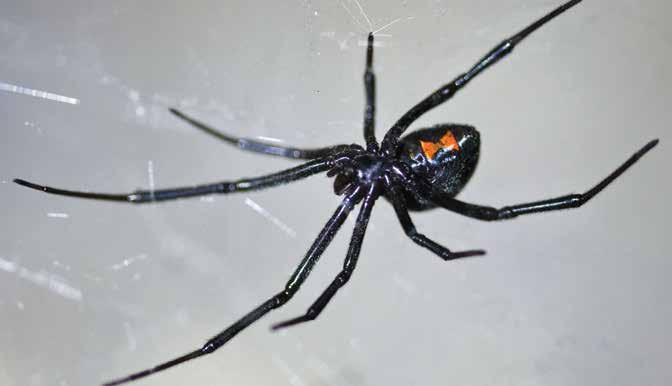
4 minute read
Kids Ask Dr. Bug
Halloween edition: creepy insect stories below. Read at your own risk!
What is a creepy insect story?
Some insect babies need fresh meat to develop. However, dead arthropods decay quickly and would not be available to insects hatching from eggs a couple of weeks after they are laid. So, their moms capture prey and paralyze it, before laying an egg on it, so the prey will be fresh when their babies hatch. An example of this is the jewel wasp. Jewel wasps hunt cockroaches. The wasp mom first paralyzes a roach with a sting, then injects a toxin directly into a specific part of the roach’s brain. This allows the wasp to steer the roach to a dark, quiet, safe place where she lays her egg on the roach’s leg. The egg hatches, consumes the roach, and grows up to repeat the cycle. I’m not a fan of roaches, but I can’t help but feel sorry for the critters!
Do insects sneeze?
To sneeze, animals need a breathing system like what we have. When we sneeze, our lungs are compressed by muscles in our chest and abs which produce that noisy blast of air out our mouth. Insects breathe through tiny holes in their abdomens called spiracles, rather than their mouths. Insects do not have lungs, either. So, sneezing (and coughing) is not something insects are able to do, which is a good thing for all the pollinating insects that might otherwise have hay fever!
Do insects fart?
Yes, some insects can be prolific farters! In fact, termites are well known to be quite gaseous, contributing over 12 million tons of methane each year! Cockroaches are another insect with a lot of gas. Roaches and termites eat a high fiber diet and have microbes in their gut that digest the food they eat. These microbes give off methane gas that is released through the insects’ anus. Not all insects are known to break wind, and there are many insects that we simply don’t know if they cut the cheese. This has been going on for a long time – there are examples of insects preserved in amber (fossilized tree resin) with tiny flatulent bubbles emerging.
I just learned about an insect that gives new meaning to “silent, but deadly!” The beaded lacewing is a tiny insect that lives in termite nests. This insect takes farting to a
whole new level by using the gas to disable their prey – termites. Termites typically overcome nest invaders, but when this lacewing lets it rip, termites are unable to move. This allows the beaded lacewing to move about freely and consume termites at will.
What did the black widow have for dinner? Read below to find out! Photo courtesy of inaturalist.org.
Do female black widows eat the males even after she has eaten something else?
Female black widow spiders are known to eat their mate, although this is not always the case. Sometimes the male can get away. However, scientists who study this in the lab find that the male is often a willing accomplice to this gruesome sacrifice, somersaulting into the females grasp. To answer your question, we need to know why the female eats the male. It turns out that that by sacrificing himself, the offspring are more likely to be his, and they will be healthier because the mom-to-be is well-fed! But that doesn’t mean the next guy to come
around is safe! She is just as likely to eat him, too.
Other arthropods are known to have similar male-sacrificing mating rituals. Although, some male insects have found ways to avoid being eaten by bringing the female a gift to eat, instead of offering themselves as the next meal.
What happens if you get bit by a brown recluse?
A bite from a brown recluse might not be noticed at first, or you might feel a sharp pinprick sensation. Bites are rare, and if they do occur, they usually cause a small wound that heals on its own. Only 10% of bites may case a serious wound that can take 2-4 months to heal. In very rare cases (<1%), a true medical emergency injury can occur, usually in young children.
Recluse spiders are just that – reclusive. They do not seek you out. Rather, they hide in sheltered locations such as under things or in crevices. If that happens to be your
clothes or shoes on the floor, you could be in for a surprise when you put them on. If for no other reason, this is a great excuse to keep your room clean!
Do you have questions about bugs found in your garden for Dr. Bug? Send them to ReallT@ Missouri.edu or bit.ly/KidsAskDrBug. Include your name and age. To help me learn what you learn from this monthly column, would you please consider filling out this survey: bit.ly/KidsAskDrBugSurvey. Thank you!
TAMRA REALL Horticulture Specialist
Dr. Tamra Reall (@MUExtBugN Garden) is the horticulture specialist for MU Extension in Jackson County. For free, research-based gardening tips, call 816-833-TREE (8733), email mggkc.hotline@gmail.com, or visit www.extension2.missouri.edu.






